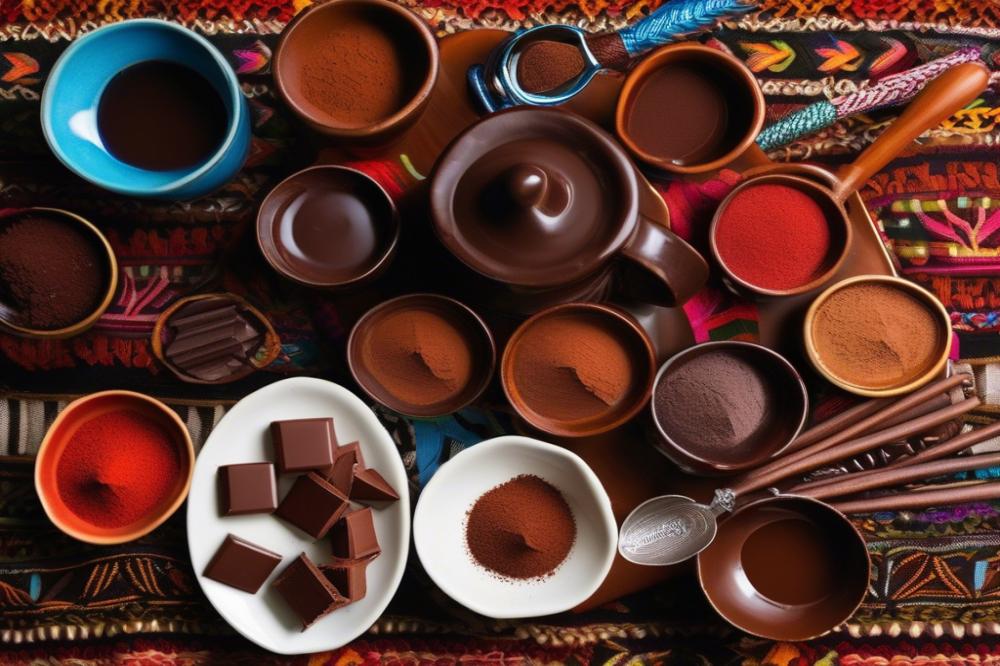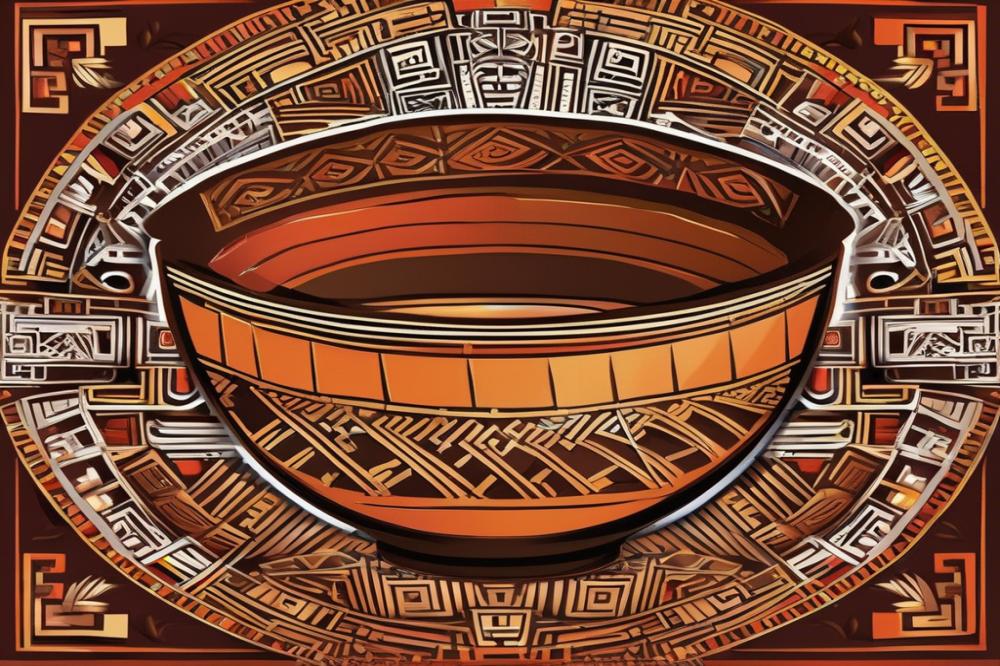Significance of Chocolate in Mexican Culture
Chocolate holds a significant place in the heart of Mexican culture. This beloved treat is more than just a flavor; it represents history, tradition, and community. It brings people together during celebrations. In many households, the preparation of traditional recipes has been passed down through generations. Chocolate is deeply intertwined with rituals and family gatherings, enhancing the rich tapestry of Mexican cuisine.
A Brief History of Cacao in Mexico and South America

Cacao has a storied past that dates back thousands of years. Ancient Mesoamerican civilizations revered the cacao bean as a sacred gift. The Olmecs, among the first, may have been the first to cultivate this vital crop. Later, the Maya and Aztecs used cacao in ceremonies and as a currency. They consumed it as a frothy, bitter beverage, sometimes spiced with chili and vanilla. This early version of drinking chocolate was far from the sweet treat we know today.
The arrival of Spanish colonizers in the 16th century changed how cacao was consumed. They introduced sugar and other flavorings, softening its bitterness. Over time, chocolate production evolved. It spread across Europe, but its roots remain firmly planted in Mexico. The blending of cultural influences helped create an array of chocolate varieties.
The Importance of Mexican chocolate Today

Today, Mexican chocolate is gaining recognition globally. Artisanal chocolate makers are reviving traditional techniques and recipes. Many are committed to using local ingredients that highlight regional flavors. Oaxacan mole sauce, for instance, often features chocolate, showcasing how this ingredient enhances savory dishes. This connection shows the versatility of cacao in the culinary landscape.
As diners become more adventurous, there’s growing interest in authentic and regional products. People want to explore the depths of flavor and history that Mexican chocolate offers. The culinary world is embracing these rich traditions, making room for new interpretations. The unique profile of Mexican chocolate continues to inspire chefs and home cooks alike. It connects them to the vibrant culture and heritage of Mexico, preserving the essence of cacao for future generations.
The History of Chocolate in Mexico
Cacao cultivation in Mexico dates back to ancient civilizations such as the Olmecs, Mayans, and Aztecs. These cultures valued cacao beans, often using them as currency. Cacao was not just food; it held deep significance in their societies. Rituals involving cacao drinks were common, especially in religious ceremonies. The Mayans prepared a frothy version of drinking chocolate, flavored with spices and served cold. This beverage became a staple at gatherings and rituals throughout Mesoamerica.
Chocolate played a vital role in social customs. It was often served at important occasions and was a symbol of wealth and status. The Aztecs considered drinking chocolate, known as “xocolatl,” a gift from the gods. They believed cacao possessed magical properties and used it in numerous sacred rites. Traditional recipes passed through generations showcase how integral cacao was to their culture.
Spanish influence greatly changed chocolate consumption and production in Mexico. When the Spanish conquistadors arrived in the 16th century, they discovered the rich chocolate beverages. They adapted these drinks, adding sugar and cinnamon to suit European tastes. This marked the beginning of chocolate’s journey to become a favored delicacy in Spain and beyond. Soon, cacao farming became a significant industry, mainly for exporting. The demand for chocolate varieties expanded, leading to different techniques in artisanal chocolate creation and mole sauce adaptations. Over time, chocolate intertwined with Mexican cuisine, reflecting the country’s diverse regional flavors.
Mexican Chocolate Varieties
Exploring different varieties of Mexican chocolate reveals a rich tapestry of flavors and traditions. These creations go beyond mere sweets; they form an integral part of culinary heritage. Each region contributes something special, influenced by local ingredients and customs, allowing for a diverse range of profiles.
Artisanal Chocolate and Its Significance
Artisanal chocolate plays a key role in modern culinary practices. Small-scale producers focus on quality and traditional methods, often using organic cacao. This appeals to a growing market that values sustainability. Craft makers take pride in their craft, often using recipes passed down through generations. By doing so, they connect consumers to chocolate history while elevating taste experiences.
Regional Flavors and Their Influence
Regional flavors significantly impact chocolate production across Mexico. For instance, Oaxacan chocolate is known for its use in mole sauce, adding depth and richness. This area specializes in a specific blend of spices and chilies, enhancing the cacao’s natural taste. Each state offers distinct elements that shape its chocolate varieties, like those from Veracruz or Chiapas.
What about drinking chocolate? It often includes cinnamon or vanilla, making it different from typical chocolates. Cocoa beans from different areas come with their own unique notes, influenced by the soil and climate. Traditional recipes hold a special place in this exploration, balanced between modern tastes and historical significance.
In summary, the variety found in chocolate reflects the wider scope of Mexican cuisine. By understanding these differences, one can appreciate not just the taste but the stories woven into every bite. Each piece of chocolate serves as a cultural artifact, rich with history and tradition.
Traditional Recipes and Uses
Mole Sauce: The Heart of Mexican Chocolate Dishes
Mole sauce is a key component in many Mexican meals. It blends various ingredients, including chilies, spices, and, of course, chocolate. This rich sauce varies by region, showcasing different flavors. In Oaxaca, for instance, mole negro stands out with its deep, earthy notes. While some recipes are complex, others can be simple and easy to prepare at home. Chocolate’s inclusion brings a sweet and savory dimension to the dish. Cooks often dedicate hours to perfecting their family recipes, passing them down through generations.
Drinking Chocolate: Traditional Preparation and Variations
Drinking chocolate has been enjoyed in Mexico for centuries. Traditionally, it is made with ground cacao mixed with water, vanilla, and sometimes spices such as cinnamon. A unique feature of preparing this beverage is the use of a “molinillo,” a wooden whisk that helps froth the drink. Variations exist across regions. Some prefer it sweeter, adding sugar or even a pinch of salt. Others like a richer flavor, incorporating nuts or fruits. In modern times, cafes offer creative takes on this drink, blending it with modern techniques while honoring its roots.
Incorporation of Chocolate in Mexican Cuisine Beyond Desserts
Chocolate goes beyond sweet treats in Mexican cuisine. It plays a role in savory dishes as well. Many traditional recipes utilize it to enhance flavors in sauces and marinades. Chicken, for instance, benefits from the addition of chocolate in certain recipes, creating a complex flavor profile. Street food vendors might also surprise diners by using artisanal chocolate in tamales or even tacos. Each dish highlights the versatility of cacao, showing off regional flavors and local traditions. Thus, chocolate’s role in these dishes connects Mexicans to their rich culinary history and cultural identity.
Crafting Mexican Chocolate: From Bean to Bar
Overview of the Cacao Production Process
Cacao is the heart of chocolate production. It all begins with cacao trees, which thrive in warm, wet climates. Farmers harvest cacao pods from these trees. Inside, they find cacao beans surrounded by sweet pulp. After collecting the pods, they open them to extract the beans. The fresh beans are then fermented. This crucial step develops the flavors we associate with chocolate. Next, beans dry in the sun, reducing moisture. Once dried, they are ready for roasting, which brings out rich aromas.
Grinding the roasted beans results in cacao nibs. These nibs can be processed further to create chocolate products. Many artisanal methods emphasize the flavors of different regions. Techniques vary across Mexico, showcasing local traditions. Each step influences the final product, producing various chocolate varieties.
Artisanal Chocolate-Making Techniques
Artisan chocolatiers play an essential role in the molding of chocolate. Using traditional recipes, they add spices and flavors. This is how mole sauce often integrates with chocolate, creating depth in cooking. Processors carefully blend ingredients to elevate flavors. Grinding cacao by hand or using stone mills can alter texture and taste immensely.
Many chocolatiers infuse their craft with regional flavors. Some might incorporate nuts or chilies. Others prefer sweetening with natural sugars or honey. These choices reflect local customs and histories. Crafting chocolate is not merely a skill; it’s an art form. Each chocolate bar or drinking chocolate tells a story.
Sustainability and Ethical Practices in Chocolate Production
Sustainability is gaining importance in cacao production. Environmental concerns drive many producers to adopt eco-friendly practices. A growing number of farmers focus on organic farming. These methods preserve biodiversity and reduce pesticide use. Supporting local farmers promotes community development as well.
Ethical practices also prioritize fair trade. Many chocolatiers source their cacao from certified farms. This ensures that farmers receive fair wages. It strengthens communities and encourages better working conditions. Consumers increasingly seek transparency in chocolate production. They want to know where their food comes from and how it’s made. With each purchase, people can support positive change in the industry.
Closing Thoughts on the Richness of Mexican Chocolate
Throughout history, chocolate has held a special place in the hearts and cultures of many regions. Mexico, in particular, boasts a remarkable legacy that intertwines ancient traditions with modern culinary practices. The distinct chocolate varieties found here, ranging from the celebrated Oaxacan mole to the velvety drinking chocolate, showcase this heritage beautifully. Each form offers a glimpse into the vibrant practices of Mexican communities, blending flavors and techniques that tell a story of identity and creativity.
Looking ahead, the global culinary landscape continues to embrace these flavors. As more people discover the depth and richness of Mexican chocolate, its impact on international cuisine is likely to grow. Chefs around the world are increasingly incorporating these diverse offerings into their dishes, inspiring a fusion of cultures and tastes. The unique profiles presented by Oaxacan chocolate and other types are setting new trends in gourmet food.
Exploring local Mexican chocolate offerings is an adventurous journey worth taking. Those who delve into this world will find a spectrum of tastes that go far beyond typical sweets. Whether at a local market or a specialty shop, there is much to discover. Plus, trying out different chocolate varieties can deepen one’s appreciation for the complex history behind them. Don’t hesitate to experience the richness for yourself and celebrate a tradition that has been cherished for centuries.



